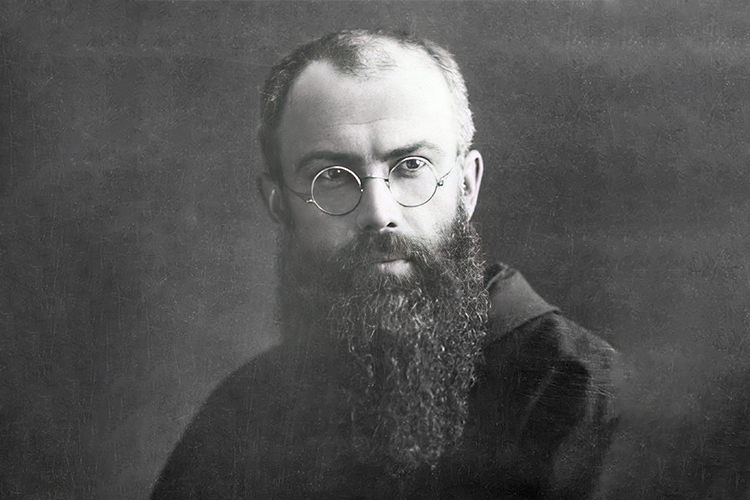
Feast day: 14 August
Summary
Saint Maximilian Kolbe was born on 8 January 1894 to a weaver, Julius Kolbe, and his wife, Maria Dabrowska; he was their second son. At an early age he had a vision of the Virgin Mary, later stating that:
“She came to me holding two crowns – one white, the other red. She asked me if I was willing to accept either of these crowns. The white one meant that I should persevere in purity, and the red that I should become a martyr. I said that I would accept them both.”
This incident had a profound effect on his life, with his own mother often seeing him praying in front of a statue of the Blessed Virgin. He would later go on as a Franciscan, to found the Militia Immaculata (Army of the Immaculate One) to fight the heresy of freemasonry, through the intercession of the Virgin Mary. He also composed the Immaculata prayer.
Imprisonment
During the Second World War, St Maximilian continuously worked against the Nazis, who by this time invaded Poland. When offered the Deutsche Volksliste (a document which would allow him to have the same rights as ordinary Germans) to sign, he refused, despite having German ancestry on his father’s side. He and the other monks at his monastery also gave shelter to refugees from greater Poland, including 2000 Jews. He also began publishing Anti-Nazi publications at the monastery. He was eventually arrested by the Nazis on 17 February 1941 and sent to Auschwitz concentration camp on 28 May.
Auschwitz concentration camp
After three prisoners had escaped from the camp, the deputy camp commander decided to take ten prisoners to underground bunkers in order to endure a slow and painful death of dehydration and starvation, in order to deter further escapes. One man who was chosen to die, Franciszek Gajownicek, was horrified and cried out “My wife! My children!” St Maximilian Kolbe then stood forward and said to the guard, “I am a Catholic priest from Poland; I would like to take his place, because he has a wife and children” as he knew this would persuade him, so he could save the stranger’s life. It was allowed, and St Maximilian went to die in Franciszek’s place.
Death
While on previous occasions the prisoners in starvation chambers were often led to despair at their fate, and often went to unhygienic extremes in order to survive, St Maximilian became a beacon of hope for the other prisoners in his cell, leading them in prayers to the Blessed Virgin Mary. After two weeks, on the 14 august 1941, when all the other prisoners had died, the guards decided to kill Kolbe by means of lethal injection with carbolic acid. Kolbe graciously accepted this death, raising his left arm, smiling and waiting for the injection. His remains were cremated on 15 August, the feast of the assumption of Mary.
Canonisation
Saint Maximilian Kolbe was canonised on 10 October 1982 by St Pope John Paul II. Franciszek Gajownicek, the man whose life St Maximilian saved, was present. While unfortunately both of Franciszek’s sons had died during the war, he was able to spend his remaining years with his wife Helena, and continued to spread the message of Kolbe’s selfless act of love towards a complete stranger, until his death in 1995.
Why Saint Maximilian Kolbe is important and inspiring
St Maximilian is a perfect example of fulfilling Jesus’ commandment to “love one another, as I have loved you” (John 15:12). This is especially seen in his work with refugees and Jews hiding from the Nazis, realising Christ in these people (Matt. 25: 31-46). This was also with the love and hope he gave to the prisoners in the starvation chamber with him, as they prayed for the intercession of Mary together.
Finally, he showed a profound amount of love of his neighbour (Luke 10:27), when he gave up his life for a complete stranger, imitating the love and mercy that God had for us when he sent his only son to die for our sins.
His acceptance of the suffering he received, both in the starvation chamber and his death by lethal injection, shows the love he had for Christ, as he was able to offer up this suffering to him.
His dedication to the Blessed Virgin Mary is also inspiring as it shows his closeness with Christ, as he was willing to dedicate and consecrate his life to the woman that would have been closest to Jesus throughout his time on earth.
Quotes
“For Jesus Christ, I am prepared still to suffer more.”
“Never be afraid of loving the Blessed Virgin too much. You can never love her more than Jesus did.”
“The most deadly poison of our times is indifference. And this happens, although the praise of God should know no limits. Let us strive therefore to praise him to the greatest extent of our powers.”
“No one in the world can change Truth. What we can do and should do is to seek truth and to serve it when we have found it. The real conflict is the inner conflict. Beyond armies of occupation and the hecatombs [e.g. the sacrifice of many victims] of extermination camps, there are two irreconcilable enemies in the depth of every soul: good and evil, sin and love. And what use are the victories on the battlefield if we ourselves are defeated in our innermost personal selves?”
“Jesus honoured her before all ages, and will honor her for all ages. No one comes to Him, nor even near Him, no one is saved or sanctified, if he too will not honor her. This is the lot of Angels and of men.”
“Let us remember that love lives through sacrifice and is nourished by giving. Without sacrifice there is no love.”